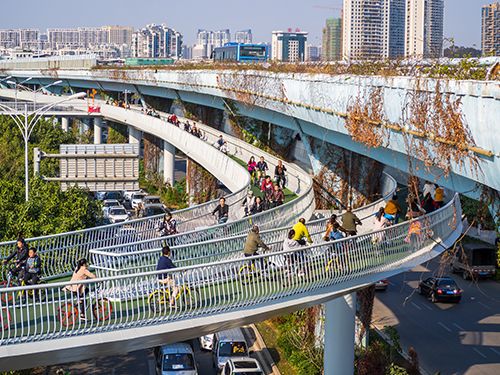Monthly Archives: December 2020
The longest bridge for bikes
As the time I am writing this post, the Skyway elevated pathway in Xiamen (China) holds the international record of the longest infrastructure of this kind. Xiamen, as well as most of the largest cities in the world, suffers from excessive road traffic, pollution and noise. China was full of bicycles decades ago, and authorities want to come back to it, at least partly. Indeed, bikes were one of the main treasures every citizen should have for Mao Zedong.
The Skyway was designed by the Danish architecture studio Dissing + Weitling, and constitutes a 7.6 kilometers long and 4.8 meters width wonder for riders. Moreover, it has pedestrian crossings, parking areas for bikes, access ramps and several intermodality stations, where you can get public transport. 30,000 led lights illuminate it.
Riding on it is so impressive that thousands of people use it everyday. From an architecture perspective, it has received awards like the Danish Design Award in the category of Livable Cities in 2019.

A Faster Commute in Amsterdam
The Incredible Underground Bicycle Parking Garages of the Netherlands
Sustainable Development Goals and bikes
The Sustainable Development Goals are a collection of 17 global targets set by the United Nations (UN) for the year 2030. They got ahead thanks to the votes of the UN member states back in 2015. The targets are:
- No Poverty
- Zero Hunger
- Good Health and Well-being
- Quality Education
- Gender Equality
- Clean Water and Sanitation
- Affordable and Clean Energy
- Decent Work and Economic Growth
- Industry, Innovation, and Infrastructure
- Reducing Inequality
- Sustainable Cities and Communities
- Responsible Consumption and Production
- Climate Action
- Life Below Water
- Life On Land
- Peace, Justice, and Strong Institutions
- Partnerships for the Goals
What does this have to do with bicycles? Well, a lot. Indeed, bikes contribute to reach 12 out of 17 goals. Let’s go step by step.
– No poverty: Bikes constitute a cheap way of transport which much more people can afford in comparison with cars or motorbikes. Investing low money on it allows using the rest of it in other issues like buying better machines if you are a local shoemaker or increase your sheep herd in case you are a shepherd.
– Zero hunger: Related with the previous point, the less money you need for transportation, the more food you can buy.
– Good Health and Well-being: You make sport when riding a bike, even if it is an electric one.
– Quality Education: The fact of costing much less than cars enables population in developing countries to use it to access to schools and colleges. Otherwise, millions of students would be forced to abandon their studies.
– Gender Equality: Pedaling does not discriminate by genres. Both, women and men do it the same way.
– Affordable and Clean Energy: By using your legs strength instead of fossil fuels when moving allows for an inevitable reduction in pollution.
– Decent Work and Economic Growth: Due to the fact that most economic stakeholders in the bike ecosystem are SMEs, and the small economy improves thanks to small workshops and bike stores, local communities benefit from bicycles.
– Industry, Innovation, and Infrastructure: Partly related with the previous goal, the more bikes, the more bike infrastructures are needed. Innovation is on the way in, for example, bicycle frames, brakes, tires, inner tubes, you name it.
– Sustainable Cities and Communities: Less pollution and energy consumption leads to sustainable societies. Bikes help reach them.
– Responsible Consumption and Production: In the process of manufacturing a bike, only the essential production resources are required. And again, the energy consumption in the use stage is considerably reduced when compared with pollutant ways of transport.
– Climate Action: Bicycles fight against climate change since they are an environmentally friendly way of transport.
– Partnerships for the Goals: The worldwide biking movement is a good example of this goal.